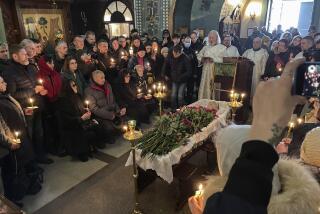Fallen Statues Reflect Fate of Fallen Leaders : Monuments: But some deplore park vandalism as an assault on the nation’s history.
- Share via
MOSCOW — The marble likeness of the late Soviet President Nikita S. Khrushchev is still recognizable, although a souvenir hunter has chipped off his nose.
Dictator Josef Stalin has been toppled from his red granite pedestal, splattered with paint and cast in the role of a playground hobby horse.
Revolutionary leader Mikhail Kalinin’s bronze statue captures him seated and deeply in thought--a pose that would be decidedly more dignified if a 13-year-old boy were not climbing on his head.
At a new park of political statuary on the banks of the Moscow River, there is no mistaking that the mighty have fallen. Some Muscovites consider the outdoor collection of defaced, uprooted monuments to be a fitting end for the misguided figures whose quest for a Communist state drove the country to the brink of ruin. But others decry what seems to be an unspoken invitation to vandalize the political relics.
“This is our history,” said Mikhail Tarasov, a television journalist from the Ukraine, as he watched schoolchildren transform the statues into a jungle gym. “We shouldn’t just bury it like so much trash.”
The sculpture garden, across from Gorky Park, is a project of the Moscow City Council Commission on Cultural Heritage, which has set up a team of experts to decide the future of other memorials honoring the 1917 Bolshevik Revolution and its legacy.
“This isn’t an exhibition, it’s a graveyard,” art student Tanya Bainova said with a nod of approval. “Our former Communist system is being buried here. They haven’t brought in the Lenin statues yet, but he’ll be here soon.”
Most of the exhibits on hand for the unceremonious opening of the park Monday were still awaiting proper display. KGB founder Felix E. Dzerzhinsky, hoisted from his Lubyanka Square mounting just over a week ago, lay flat on his back amid the grassy display ground outside Moscow’s Central Exhibition Hall, one tarnished bronze hand in his pocket, the other gripping his cap.
Khrushchev’s massive bust also awaits uprighting and rests at the rear of the outdoor museum. The ignominy of his presentation is accentuated by the fact that someone has taken a hammer and chisel to his white marble nose.
Stalin, whose polished statue is of mysterious origin as few survived the purge of his image over the past 35 years, has been spattered with red paint as a reminder of the blood spilled during his tyrannical rule.
Oddly, the bust of Lavrenti Beria, Stalin’s hated secret police chief, appears unscathed, despite its front-and-center placement in the unmonitored park.
The open-air museum drew hundreds of strollers on its opening day. Many were dismayed by the rough treatment of their past.
“It’s necessary to find a new place for these leaders in our history, but it should be done correctly,” said Yuri Dukhnovsky, a technician at the Moscow Enterprise for Writing Instruments, which until recently was named the Sacco and Vanzetti Pencil Factory.
“I lived through the era when everyone rushed to take down Stalin’s pictures and monuments, and that time was not a proud moment for us, either,” the 52-year-old Muscovite recalled.
Some found the idea of a museum displaying disgraced leaders a proper treatment of Soviet history but deplored the haphazard handling of the once-hallowed monuments that have been laid open to theft and destruction. “This should be a place where we can take children and talk about this sad chapter of our history,” observed one young women, shaking her head in dismay at the surrogate playground.
Dima Konstantinov, a 13-year-old sporting the blue uniform worn for Monday’s first day of school, whooped victoriously when he managed to climb to the shoulders of Kalinin’s 12-foot-high statue.
Asked if he knew who the memorial represented, he grimaced and admitted: “No, I don’t recognize this one. But that’s Stalin over there.
“Hey, Zhenya!” he yelled to a friend mounting the toppled Stalin. “Who’s this?”
More to Read
Sign up for Essential California
The most important California stories and recommendations in your inbox every morning.
You may occasionally receive promotional content from the Los Angeles Times.














